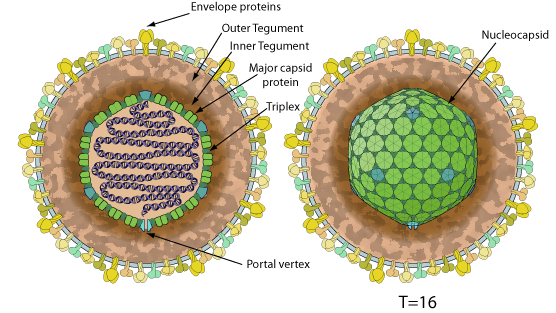Rhadinovirus (taxid:10379)
VIRION

Enveloped, spherical to pleomorphic, 150-200 nm in diameter, T=16 icosahedral symmetry. Capsid consists of 162 capsomers and is surrounded by an amorphous tegument. Glycoproteins complexes are embedded in the lipid envelope.
GENOME
Monopartite, linear, dsDNA genome of about 180 kb. The genome contains terminal and internal reiterated sequences.
GENE EXPRESSION
Each viral transcript usually encodes a single protein and has a promoter/regulatory sequence, a TATA box, a transcription initiation site, a 5' leader sequence of 30-300 bp (not translated), a 3' untranslated sequence of 10-30 bp, and a poly A signal. There are many gene overlaps. There are only few spliced genes. Some of the expressed ORFs are antisense to each other. Some ORFs can be accessed from more than one promoter. Certain proteins are downregulated translationaly by a leaky scanning from an upstream ORF.
ENZYMES
- DNA-dependent DNA polymerase
- DNA primase
- Tegument deneddylase (Peptidase C76)
- Assemblin (Peptidase S21)
- Kinase
- Helicase
- Ribonucleoside-diphosphate reductase
- Thymidine kinase
- Uracil-DNA glycosylase
REPLICATION
NUCLEAR
Lytic replication:
- Attachment of the viral glycoproteins to host receptors mediates endocytosis of the virus into the host cell.
- Fusion with the plasma membrane to release the core and the tegument proteins into the host cytoplasm.
- The capsid is transported to the nuclear pore where the viral DNA is released into the nucleus.
- Transcription of immediate early genes which promote transcription of early genes and protect the virus against innate host immunity.
- Transcription of early viral mRNA by host polymerase II, encoding proteins involved in replication of the viral DNA.
- A first round of circular genome amplification occurs by bidirectional replication
- Synthesis of linear concatemer copies of viral DNA by rolling circle.
- Transcription of late mRNAs by host polymerase II, encoding structural proteins.
- Assembly of the virus in nuclear viral factories and budding through the inner lamella of the nuclear membrane which has been modified by the insertion of herpes glycoproteins, throughout the Golgi and final release at the plasma membrane.
Latent replication : replication of circular viral episome in tandem with the host cell DNA using the host cell replication machinery.
Host-virus interaction
Adaptive immune response inhibition
Kaposi proteins MIR1/K3 and MIR2/K5 are E3 ubiquitin ligase which promote the ubiquitination and subsequent degradation of host MHC-I and CD1D molecules, thereby inhibiting the host adaptive immune response.
Apoptosis modulation
Kaposi sarcoma-associated herpesvirus encodes a viral FLICE inhibitory protein (vFLIP) that blocks apoptosis  .
.
Autophagy modulation
The KSHV v-Bcl-2 inhibits host autophagy by interacting with host beclin-1  .
.
Cell-cycle modulation
KSHV v-cyclin encoded by ORF72, is a cyclin-like protein that shares homology to cellular D-type cyclins. Like human cyclins, v-cyclin interacts with cdk4 and cdk6 to activate these kinases and promote the G1/S phase transition.
The conserved UL24 family of human alpha, beta and gamma herpesviruses induces a cell cycle arrest at G2/M transition through inactivation of the host cyclinB/cdc2 complex. EBV encodes an UL24 homolog termed ORF20 that should perform this role  .
.
Innate immune response inhibition
Human herpes virus 8 (HHV-8) has developed unique mechanisms to modulate host immune system by incorporating viral homologs to several cellular regulatory genes into its genome. For instance, vIRF-1 is able to bind to both IRF-3 and IRF-7 and efficiently inhibits the formation of transcriptionally competent IRF-3-CBP/p300 complexes  .
.
Splicing inhibition
KSHV ORF57 modulates the viral and host mRNA expression by exporting unspliced mRNA, thereby inducing alternative splicing  .
.
Matching UniProtKB/Swiss-Prot entries
(all links/actions below point to uniprot.org website)0 entry grouped by strain
